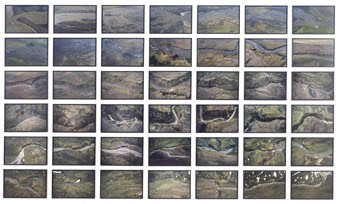
There can be no better way to begin a new year than to have someone show you the world afresh. Sydney's MCA is the latest home of Olafur Eliasson's well travelled review show 'Take Your Time' and so is graced with rare magic and light. The retrospective includes thirty works across fifteen years (although heavily weighted to the 2000s) and might be the best show the MCA has had for years. It's moving, intelligent and joyously accessible.

'Remagine' is a set of simple rectilinear projections from seven spotlights onto three walls of a square room. It couldn't be simpler, even when the shapes overlap and intersect creating the illusion of depth and space. This isn't 'Avatar' though, the simple shapes are like a meditation on linear perspective and the space within the gallery. This deconstruction through planes and lines of light makes one acutely aware of the way in which we can enter a work of art. However it never suffers from becoming a lecture or a statement, it is open ended and engaging and I can't help imagining how beautiful it would be to see it beside a Piero Della Francesca. The juxtaposition isn't that strange. The early renaissance used a geometrical concept to better explore the way individual's inhabit their world, what Eliasson does isn't so different.

A familiar Eliasson project is 'The cubic structural evolution project', which you probably know as the long table full of white lego. When I came across it before my first thoughts were that this was an attempt to get kids into galleries. Having spent at least half an hour on my own edifice I think I know the spirit of the work. To sit an make lego sculptures, borrowing bits from others and knowing that yours might be broken or built on creates a spontaneous and unprecious sense of creativity. Sat at the table were Mums and kids, dating couples, serious teenagers and curious grannies. It's interesting to see the varieties of intent, the breaking down of barriers and the shared pleasure of almost egoless work. Oddly two things do seem to jar against this playful praxis, and that's the MCA's petty prohibition on photos and the 'serious' sculptural Lego works sitting in superior isolation around the edge of the room. I was quite proud of my tower, with its intersecting spirals, but I think it would be a shame to deprive someone of the pleasure they could have with my blocks.

Eliasson is so much associated with the play of light and the participation of people that it's a surprise that the key to so much of his work comes in a room filled with five large scale photographic series. Aerial photographs of rivers and their surrounding landscapes, horizons or caves the photos are arranged, individually framed in black, in rows and columns. They are so different from the immersive abstraction of so many of the other works that their point appears clear. His work is real and solid, it is not about tricks and illusions but real lived sensation and emotion. Eliasson is fascinated by our sensory experience of the world we inhabit, how light and texture and space can be used to capture what it is to be human. This sets him light years away from dry formalism or glib concepts, his power comes from empathy.

The final room one arrives at houses the earliest work here, 'Beauty' a black space with a spray of water and a spotlight. At its most simple Eliasson has created a rainbow in the darkness but as beautiful as that might be the whole effect of the piece is far greater. As you move through the room the effects on light refracted through water changes but something far more powerful happens. The darkness and the room width line of mist seem to invite people to step in and through, and to laugh and talk, it's very un-gallerylike without feeling like a side show. It manages to be both contemplative and social, inside and out, dark and light. I like that Eliasson manages to create works that are so directly engaging. I have always studiously avoided talking about crowds and audiences in there reviews here but 'Take Your Time' positively demands it. From room to room strangers talked to one another, and they talked about the work, about how it felt without a hint of the classic art gallery whisper of "What's that all about then?"
Until now I had thought of Eliasson as a big event kind of artist, the danger of that sort of mis-conception is understandable when you encounter such splashy works as 'New York City Waterfalls' or Tate Modern's 'The Weather Project' through the media. That seems a deeply unfair view now, and I regret never having experienced those pieces. It might be that Olafur Eliasson restores a sense of wonder in that prism through which we see our world called art and in contrast to fashionable cynicism Eliasson's work is a sincere and democratic art. So much of this work is palpably generous in spirit, it invites people to interact without condescension. This is the essential exhibition in Sydney this summer and fall.








No comments:
Post a Comment